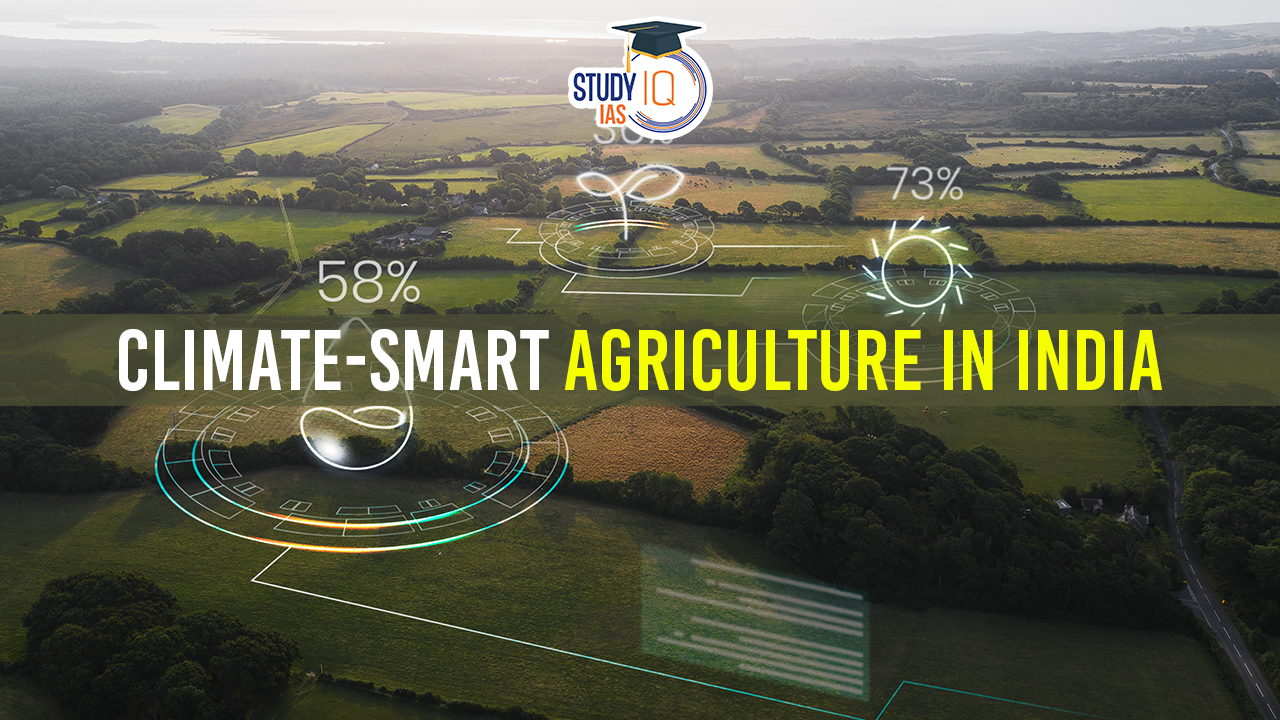Table of Contents
Context: Climate-smart agriculture has the potential to assure food security, empower farmers, and protect our delicate ecosystems.
What Is Climate Smart Agriculture?
According to the Food and Agriculture Organization (FAO), Climate-Smart Agriculture (CSA) is a strategy aimed at transforming and redirecting agricultural practices towards sustainable development, ensuring food security amidst the challenges posed by climate change.
We’re now on WhatsApp. Click to Join
Objectives of Climate Smart Agriculture
- Three pillars or objectives:
- sustainably increase agricultural productivity and incomes;
- adapt and build resilience to climate change; and
- reduce/remove GHG (greenhouse gases) emissions, where possible.
- Includes practices such as water-smart techniques (efficient utilisation of water), weather-smart approaches (adapting to weather variations), energy-smart strategies (efficient energy use), and carbon-smart methods (reducing the carbon footprint).
Significance of Climate Smart Agriculture
- Adapting to Climate Change: CSA encourages the use of diversified crops and drought-resistant varieties, improving water efficiency, which is vital for adapting to climate change.
- Boosting Farm Productivity: CSA enhances agricultural efficiency in a sustainable manner, which is critical as the global demand for food is expected to rise by 60% by 2050.
- Reducing Greenhouse Gas Emissions: CSA plays an important role in lowering greenhouse gas emissions. This is significant, given that agriculture accounted for 17% of global emissions in 2018.
- Environmental Conservation: CSA’s ecosystem-based approach facilitates the harmonious coexistence of croplands with natural areas, aiding in the protection of native species and pollinators.
- Ensuring Long-Term Food Security: CSA contributes to sustainable food security, a necessity in a world facing a growing population and evolving dietary preferences.
- Flexibility and Wide-Ranging Implementation: CSA is characterised by its versatility and broad applicability, allowing for effective implementation across various agricultural environments and regions.
- Socio-Economic Benefits: CSA provides farmers, particularly those in vulnerable positions, with access to climate-resilient techniques and information, fostering socio-economic transformation.
Initiatives for Climate Smart Agriculture
Global
- Alignment with Sustainable Development Goals: CSA supports the United Nations’ Sustainable Development Goals, focusing on eradicating hunger and promoting environmental stewardship via sustainable farming practices.
- Contribution to the Paris Agreement: Practices within CSA, such as agroforestry and carbon sequestration, contribute to the goals of the Paris Agreement by aiming to lower greenhouse gas emissions.
India
- National Innovation on Climate Resilient Agriculture (NICRA):
- Launched in 2011 by the Indian Council of Agricultural Research (ICAR).
- Aims: To increase the resilience of Indian agriculture, including crops, animals, and fisheries, to climate variability and change.
- National Action Plan on Climate Change (NAPCC): It was launched in 2008 to mitigate and adapt to the adverse impact of climate change. It includes various “National Missions” focusing on climate change awareness, adaptation and mitigation, energy efficiency, and natural resource conservation.
- National Mission on Sustainable Agriculture (NMSA): It is one of the eight Missions under the NAPCC that seeks to address issues regarding ‘Sustainable Agriculture’ in the context of risks associated with climate change by devising appropriate adaptation and mitigation measures.
- National Adaptation Fund for Climate Change (NAFCC): It was established in 2015 to meet the cost of adaptation to climate change for the State and Union Territories of India that are particularly vulnerable to the adverse effects of climate change.
- Climate-Smart Villages (CSV): CSV is an institutional strategy to implement and promote CSA at the local level, enhancing farmers’ ability to adapt to climate change. CSVs undertake a portfolio of actions to address climate challenges, covering various farm activities.
- Pradhan Mantri Krishi Sinchayee Yojna (PMSKY): Launched to prioritise water conservation and management in agriculture, PMSKY aims to expand irrigated areas. It focuses on “More crop per drop” by offering end-to-end water solutions, from source generation to delivery networks.
Challenges of Climate-Smart Agriculture
- Unpredictable Weather and Climate Change: The variability of weather patterns and the impacts of climate change pose significant challenges to climate-smart agriculture. For instance, India ranks seventh among countries most affected by extreme weather events, as per the Global Climate Risk Index 2020.
- Resource Limitations for Small Farmers: Small-scale and marginal farmers often struggle with limited access to capital, technology, and knowledge necessary for adopting climate-smart practices.
- Gaps in Technology and Knowledge: Effective implementation of climate-smart methods requires both access to suitable technologies and comprehensive knowledge. Many farmers lack the necessary awareness and technical expertise.
- Institutional Hurdles: The expansion of climate-smart agriculture is often impeded by weak institutional support, insufficient policies, and governance challenges.
- Financial Barriers: Implementing climate-smart agricultural practices frequently demands upfront investments in new technologies and infrastructure, which can be a significant obstacle, particularly in economically disadvantaged areas.
- Need for Localised Adaptation: Climate-smart agriculture must be customised to fit specific local conditions and agro-ecological zones, requiring unique solutions and adaptations for different regions.
Way Forward
- Climatic Risk Assessment: While some may face water shortages, others might struggle with frequent flooding. This necessitates tailored approaches. In India, smallholder farmers are adapting to various climate hazards, such as the potential loss of rainfed rice cultivation land due to climate change.
- Access to Climate-Smart Technologies: Bridging the gender gap in technology access and reducing greenhouse gas emissions through improved fertiliser use, water management, and livestock practices.
- Enabling Policy Integration: Governments need to create and enforce policies that support CSA, integrating it into national agricultural strategies and plans. In India, government initiatives like the National Adaptation Fund and the Soil Health Mission are steps towards institutionalising support for CSA.
- Promoting Knowledge and Capacity Building: Encouraging knowledge-sharing and enhancing skills among farmers, extension workers, researchers, and policymakers is crucial. This can be achieved through training programs and the use of digital technology. In India, agro-advisory services, and community-based water management practices are examples of knowledge transfer and capacity building in CSA.
- Investment in Research and Development: There’s a need to invest in R&D to better understand the effects of climate change on agriculture and to develop climate-resilient crop varieties, innovative cropping systems, and climate information services. The work of the International Rice Research Institute (IRRI) in breeding new varieties of rice suitable for dry and puddled direct-seeded systems in India.
- Advancing Climate-Smart Livestock Production: Sustainable livestock management practices should be promoted. This includes improving feed efficiency, better waste management, and the use of climate-resilient cattle breeds. In India, initiatives like improving livestock breeding systems for increased productivity and reduced greenhouse gas emissions are indicative of advancements in climate-smart livestock production.


 Climate Migration in India, Challenges a...
Climate Migration in India, Challenges a...
 India’s Carbon Credit Trading Scheme, ...
India’s Carbon Credit Trading Scheme, ...
 Operation Shiva 2025: Indian Army’s Ma...
Operation Shiva 2025: Indian Army’s Ma...





















